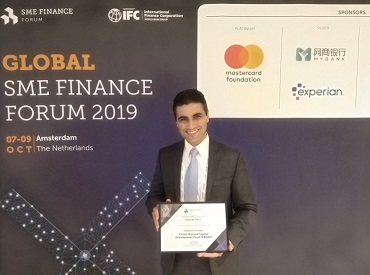Blog
Implementing an SME Finance Program - The Diamond Bank Experience

I was inspired to write The Guide to SME Financing not by the positive experience in Nigeria during 2009-2010 when I pioneered the approach to semi-automated SME finance featured in the book, but by a largely negative experience in Iraq a year later when I was part of a USAID-funded project with the commercial banking sector that, for a variety of reasons, never really got off the ground. Having a bad one makes you realize what a good one is. And it makes you appreciate it.
Post commercial banking career, I got involved (or re-involved, as I am a former Peace Corps volunteer) in development work in the mid-1980s and soon gravitated towards finance projects. I dabbled in ag coops, did some micro-finance, then finally came ashore to my developmental home base - SME finance.
In 2009, I took a position in Nigeria as IFC advisor to Diamond Bank, plc, in Lagos. Diamond was (and is) a largish, but not one of the largest, Nigerian commercial banks with a nationwide network of 200 branches. Diamond’s keen interest in participating was instrumental in its selection for the AMSME program, the IFC’s Africa Micro-, Small- and Medium-Scale Enterprise Finance program: Diamond was chosen ahead of several better-known and larger Nigerian banks.
I had never dealt with such a large client bank before, and realized that my customary labor-intensive manual approach to SME finance would simply not do. We needed to automate things, yet I was adamant that whatever approach we adopted retain a solid credit analysis foundation. I was assigned a terrific sidekick, Chima Nnadozie, and together we worked with the IT department and consulted closely with branch managers in Lagos to design a system that would deliver two SME lending products, a fixed asset loan and a working-capital facility, which I designated a “revolving credit” to distinguish it from an overdraft line. As a good American banker I have a strong aversion to overdraft finance.
I started with the fixed asset (F/A) loan, and that proved to be a mistake – market demand was all about the working capital loan, as it turned out. The product we designed was also a bit unwieldy and my colleagues at the IT department put a “time-out” feature into it that meant bankers had to complete the application form in a hurry and at one sitting or else lose all the information they had input. There was no “save” feature, as this was judged to be a potential security breach. To make a long story short, the branch bankers rebelled, refused to use the platform, and we were stuck with a dud. Back to the drawing board.
We dropped the fixed asset loan for the moment and two months later came out with the revolving credit (R/C). It worked from the same platform as the fixed asset loan but the design was slicker, no time-out problems, and pilots with selected branches helped streamline the program to make it hum. From a position of very little to show in outstandings for my overseers at the IFC, we soon had a very substantial portfolio. Shortly after the R/C was rolled out, we added a new, improved F/A loan using the same application/analysis/approval platform.
Training covered the entire 200-branch system, and within 15 – 16 months of program inception, we had the entire country using the platform.
Credit approvals were handled through a Loan Production Unit in Lagos, where the applications/analyses – with pro-forma financial statements (largely computer-generated) and branch recommendations for credit extension – arrived and initial approvals (or rejections) issued within 24 hours (usually). We advertised a three-day “Yes” or “No” on loan applications and were able to deliver it.
As an old-fashioned banker, I insisted that all the branch lending staff receive credit training (in addition to the specific training on the SME lending products): we contracted a firm to design and deliver a 10-day course AND endeavor to find the course a home within Diamond Bank in order that it be offered in the future. I am convinced that credit-trained staff - even with only a short course behind them - are the best bulwark against loan losses. An added benefit is the increased professionalism of a cadre of loan officers who are bankers not clerks.
By the end of the two years the Diamond Bank program had over $32 million in SME loans outstanding, and a past due percentage of 0.3%.
Lessons learned from this experience are the basis for the system described in the Guide. The book provides a complete, step-by-step approach to setting up an SME lending program in a commercial bank (or other financial institution), and features a semi-automated lending platform.

















